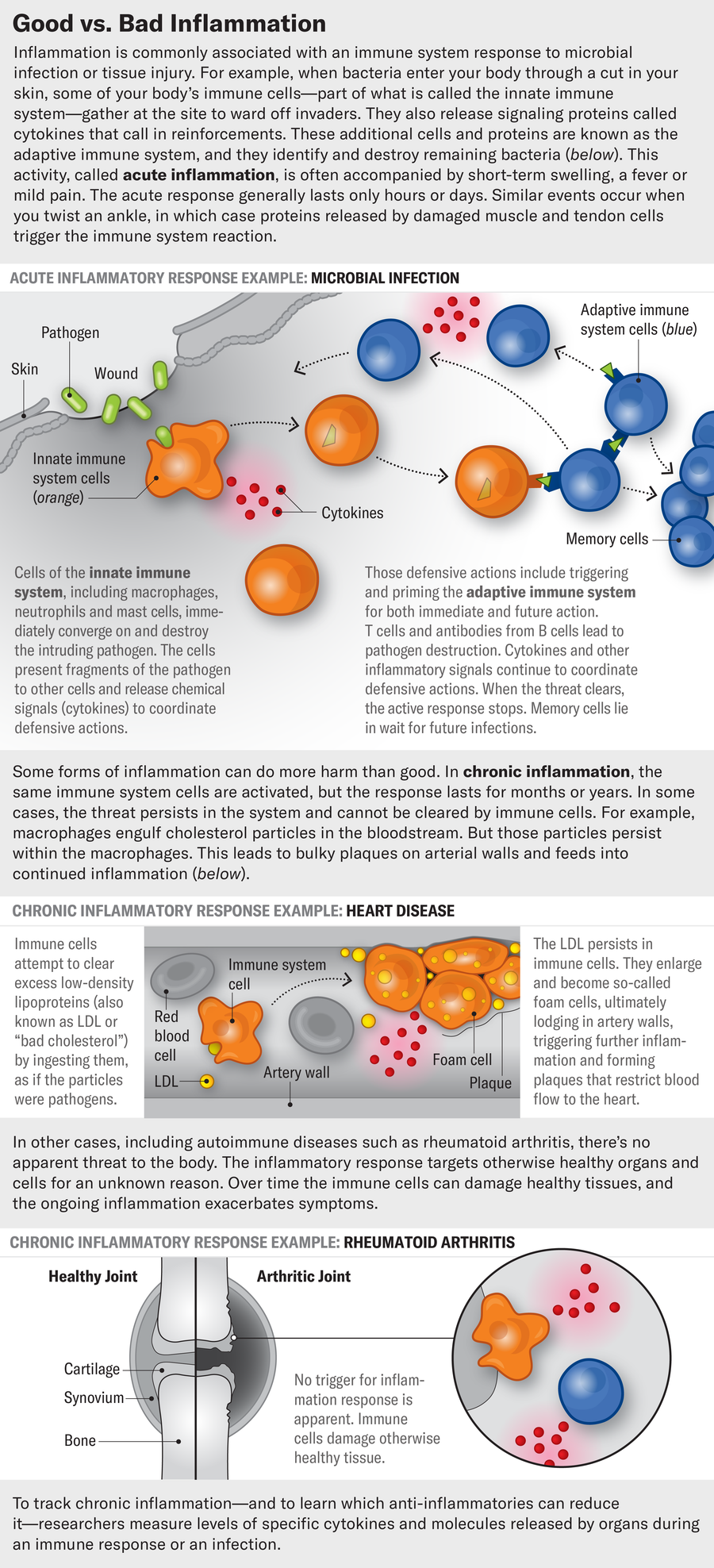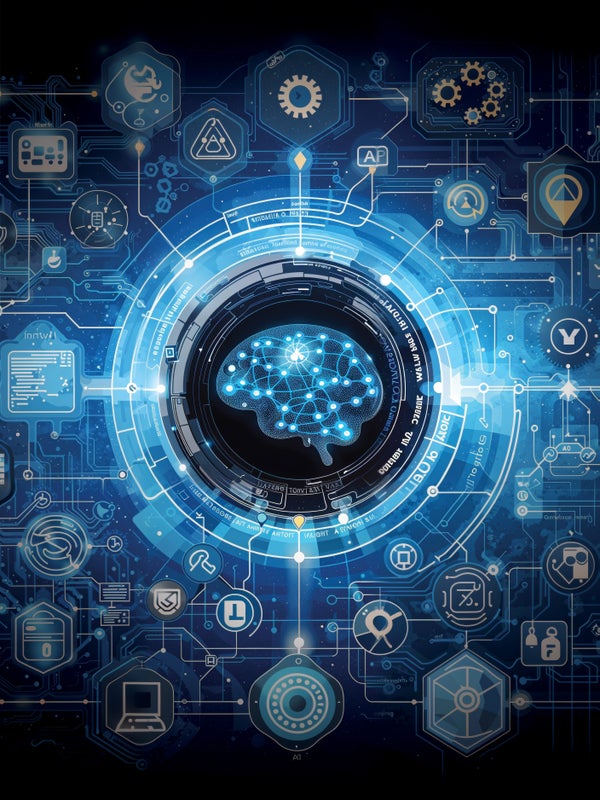Which Anti-Inflammatory Supplements Actually Work?
Experts say the strongest scientific studies identify three compounds that fight disease and inflammation

Capsules of omega-3 fatty acids show some of the best evidence as anti-inflammatories.
Mensent Photography/Getty Images
Experts say the strongest scientific studies identify three compounds that fight disease and inflammation
Inflammation has two faces. It can be short-lived like the swelling after a twisted ankle or a two-day fever when you get a mild flu, both part of the healing process. Or it can be a longer-lasting and more damaging affliction—chronic, low-grade inflammation that lingers in the body for years without obvious symptoms, silently harming cells. A steady stream of studies has connected this type of chronic inflammation to many serious conditions, including Alzheimer's, heart disease, some cancers, and autoimmune illnesses such as lupus.
These findings have begun to reframe how scientists think about disease and some of its causes. They've also created a booming market for supplements promising to lower chronic inflammation. These pills, capsules and powders are projected to become a $33-billion industry by 2027, offering consumers a sense of control over a complex and confusing ailment. Although thousands of products claim to "support immunity" or "reduce inflammation," most lack solid evidence.
Chronic inflammation is damaging because it involves immune system cells and proteins that typically fight short-term battles against bacteria, viruses, and other pathogens. But when these immune system components stay activated for years, they begin to hurt healthy cells and organs. They are intended to break down invading microbes, but over time their ongoing activity can harm blood vessels, for instance, by damaging normal cells that make up the vessels' inner linings or promoting the growth of plaques. That can lead to clots that interrupt or cut off blood flow, increasing the risk of heart attacks and strokes.
On supporting science journalism
If you're enjoying this article, consider supporting our award-winning journalism by subscribing. By purchasing a subscription you are helping to ensure the future of impactful stories about the discoveries and ideas shaping our world today.
We reviewed dozens of studies and spoke with researchers to find out whether any supplements demonstrate anti-inflammatory activity not just in laboratory animals and cultured cells but in human trials. Just three compounds, it turns out, have good evidence of effectiveness: omega-3 fatty acids, curcumin and—in certain ailments—vitamin D.

What is good evidence? We looked for consistent results across several studies that scientists described as large and well designed. Many of the more convincing trials focus on biomarkers that researchers use to track inflammation in the body. These include C-reactive protein (CRP), a molecule produced by the liver when inflammation is active, and cytokines, which are chemical messengers such as interleukin-6 (IL-6) and tumor necrosis factor alpha (TNF-α), both secreted by immune and fat cells.
Still, interpreting these markers isn't straightforward. "We don't have a universally accepted or standardized measurement," says Frank Hu, chair of the department of nutrition at Harvard University. And inflammation involves hundreds of different types of cells and many signaling pathways, adds Prakash Nagarkatti, director of the National Institutes of Health Center of Research Excellence in Inflammatory and Autoimmune Diseases at the University of South Carolina. This complexity makes it difficult to prove that any supplement works consistently.
The compounds that do show promise will not cure cancer or halt dementia. But they may help quiet the kind of underlying inflammation that has been tied to risks of illness.
OMEGA-3 FATTY ACIDS

Herring is a rich source of omega-3 fatty acids.
Among the hundreds of supplements tested for their effects on human health, omega-3 fatty acids are supported by some of the most compelling evidence. And scientists understand why they work. Two of the main types of omega-3s are eicosapentaenoic acid and docosahexaenoic acid, better known as EPA and DHA. The body metabolizes them into signaling molecules that block the production of certain cytokines and disrupt the nuclear factor κB pathway, which governs the expression of genes tied to inflammation.
Multiple studies suggest that omega-3 supplements can reduce markers of chronic inflammation, Hu says, especially among people with underlying health conditions. A large, carefully controlled trial called VITAL (officially the Vitamin D and Omega-3 Trial), which followed more than 25,000 adults for about five years, found that omega-3 supplements slightly reduced CRP in people who rarely ate fish—fish is a natural omega-3 source, so these people were getting almost all their omega-3s from the supplements. The omega-3 supplements also were associated with a 40 percent reduction in heart attacks among those consuming the least fish. "The people who benefit the most from these supplements are people who start out with lower intake," says JoAnn Manson, an endocrinologist at Harvard Medical School who co-led the study.
Smaller trials have suggested that omega-3 supplementation can reduce certain markers of inflammation—TNF-α, IL-6, CRP and IL-8—especially in people with conditions such as heart failure, Alzheimer's and kidney disease. One 2012 trial found that small amounts—about 1.25 or 2.5 grams per day—lowered IL-6 levels by 10 or 12 percent, respectively, over four months. A similar group got a placebo instead, and their IL-6 levels increased by 36 percent during that period.
Taking omega-3 fatty acid supplements was associated with a 40 percent reduction in heart attacks among people in a trial who ate the least amount of fish.
But the evidence across various trials is hard to compare. "There is still a question regarding which is the optimal dose and the optimal duration because different studies have used different doses," Hu says. And in healthy people, who have low baseline inflammation, there might be little room for improvement.
VITAMIN D

Egg yolks contain some vitamin D.
Rigorous trials have debunked the once popular idea that vitamin D is a wonder drug for everything from breast cancer to diabetes. For a few autoimmune conditions, however, the vitamin can be helpful. In the VITAL trial, people who took vitamin D daily for five years had a 22 percent lower risk of developing autoimmune diseases such as rheumatoid arthritis, psoriasis and lupus. "High-dose vitamin D has the effect of tamping down inflammation," Manson says. "So conditions that are really directly related to inflammation may benefit."
Lab studies have suggested that vitamin D may interfere with molecular pathways involved with inflammation, in addition to suppressing the production of proinflammatory cytokines. And in a handful of clinical trials in people with autoimmune conditions, vitamin D supplementation appeared to reduce levels of proinflammatory cytokines such as TNF-α, as well as CRP. In one small study of women with type 2 diabetes, a high dose—50,000 international units (IU) every two weeks—reduced CRP. It also increased levels of IL-10, an anti-inflammatory molecule.
A separate study in women with polycystic ovary syndrome (PCOS) found that a combination of vitamin D and omega-3 fatty acids helped to lower CRP levels. And two analyses that grouped together results from several studies back up the idea that the vitamin can cause a significant, though small, reduction in CRP. Another trial in women with PCOS found that a daily dose of 3,200 IU of the vitamin improved patients' insulin sensitivity and liver function. It didn't affect inflammatory markers, however.
Other studies haven't found consistent effects. The VITAL study reported that people who took vitamin D saw a 19 percent drop in CRP levels by the two-year mark, but this difference disappeared by the fourth year. Whether that two-year dip in inflammation translates into long-term benefits remains unclear, the researchers note. Even then, the findings may also depend on baseline levels. Most people in the VITAL study started with normal levels of vitamin D, Manson says. "People who are already getting reasonable intake may not benefit further from the supplement," she says. A review of other trials looking at inflammation-related biomarkers such as CRP, IL-6 and TNF-α found that vitamin D supplementation at several different doses didn't have a big effect.
As with omega-3s, the varying doses in the different trials may be behind the inconsistent results. Very high weekly doses—40,000 or 50,000 IU—may be necessary. (The recommended daily vitamin D intake for adults is 600 IU.) But high doses carry their own risks, such as too much calcium in the blood.
Although the findings on autoimmune illnesses are intriguing, the American College of Rheumatology still has a conditional recommendation against the use of supplements, instead advocating that people make dietary changes to try to get the recommended vitamins and nutrients from food. Inflammation is central to illnesses such as rheumatoid arthritis, says Arthur M. Mandelin II, a rheumatologist at Northwestern University's Feinberg School of Medicine, but he is interested in vitamin D only as a therapy for patients with demonstrated deficiencies.
CURCUMIN

The spice turmeric contains curcumin.
The pigment that gives turmeric its yellow color, curcumin, is another promising compound for fighting chronic inflammation. The substance seems to interfere with the nuclear factor κB pathway, "the apex of inflammatory cascades in the body," explains Janet Funk, a professor of medicine and nutritional sciences at the University of Arizona, who has evaluated hundreds of human trials on the compound.
Funk's review found that the most convincing evidence for curcumin's anti-inflammatory activity was among small clinical trials. People in those trials had preexisting conditions such as metabolic disorders and osteoarthritis. In a few cases, curcumin's effects resembled those of over-the-counter anti-inflammatory drugs such as ibuprofen. "These small trials—and there are a lot of them—all sort of point to it probably being beneficial," Funk says.
The caveats in Funk's language, however, reflect the ambiguity of other results. A large Canadian trial found no measurable benefit for inflammation in people who were taking curcumin after surgery, and other trials have been inconclusive. One reason for the inconsistency is curcumin's bioavailability: the substance is poorly absorbed in the gut, rapidly metabolized and quickly cleared from the body. Some supplement manufacturers encase curcumin in nanoparticles to improve its absorption, but these formulations aren't always used in clinical trials, nor are they consistently available over the counter.
Some commercial turmeric and curcumin powders have even been found to contain harmful contaminants such as lead. "People buy turmeric powder based on its color," Funk says. "Partly to make it a more beautiful color, [manufacturers] add lead chromate."
Other compounds such as flavanols in green tea and dark chocolate or resveratrol in red wine are often promoted as anti-inflammatory agents. But their supporting evidence is weaker, Hu says. They can be hard for the body to absorb, which limits their effectiveness. In the case of resveratrol, the compound is metabolized and cleared so quickly it's unlikely to have any true impact. And even though a recent trial of cocoa flavanols found a promising effect on cardiovascular health, possibly because of reduced inflammation, any benefit might be outweighed by the many extra calories one would consume if they got the compounds by eating chocolate.
Supplements aren't regulated like drugs. The U.S. Food and Drug Administration doesn't require supplement companies to prove that their products improve health, unlike pharmaceuticals. So there's little financial incentive for these companies to run rigorous clinical trials because, as Funk asks, "What if they find out it doesn't work?"
Such trials would also be difficult to run. Supplement ingredients can vary from batch to batch, especially for botanically derived products, in which concentrations depend on where the plants are grown and how the crucial components are extracted. Even when trials are well designed, they can come up against ethical challenges. "You cannot really preselect people on the basis of being deficient or profoundly deficient in these essential vitamins," Manson says, "because once you identify them as being profoundly deficient, you really should be treating them" and not giving half of them placebos in a multiyear trial.
Still, the appeal of supplements is obvious. We all want simple solutions to complex medical problems, especially as we learn more about the damaging effects of chronic inflammation on health. "The patient who spends a good deal of the visit focusing on diets and supplements is also that patient who's very fearful of medication," says Mandelin, the Northwestern rheumatologist. "They're ready to write [the names] down as if there is some magic answer, and unfortunately there isn't."
Instead experts recommend what good medical studies have shown to work: a healthy and balanced diet. Mediterranean-style diets, which are rich in vegetables and whole grains with some fish and poultry, have especially been shown to reduce chronic disease and to promote good health. Regular physical activity helps, too. "Many people think that they can just take a dietary supplement, pop the pill, and that replaces a healthy diet," Manson says. "That is not at all the case."


